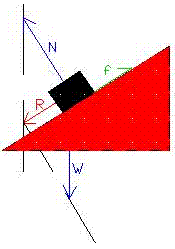is a material property, defined as the ratio of
the Friction force (F)
to the Normal (N)
force. The friction force is the product of the coefficient of friction
and the Normal force. The coefficient of friction can be static or kinetic,
and varies according to the material properties; its value is determined
experimentally.
Friction is the force that resists the (sliding) motion
of two surfaces in contact. The force of friction is present everywhere two
objects are in contact. It is easily observed when one attempts to displace
a block sitting atop a table.
The Friction force is directed in the opposite
direction of the Resultant Force acting on a body. In the case of kinetic
friction, the direction of the friction force may or may not match the
direction of motion: a block sliding atop a table with rectilinear motion is
subject to friction directed along the line of motion; an automobile making
a turn is subject to friction acting perpendicular to the line of motion (in
which case it is said to be 'normal' to it). A motionless body is subject to
static friction. The direction of the static friction force can be
visualized as directly opposed to the force that would otherwise cause
motion, were it not for the static friction preventing motion. In this case,
the friction force exactly cancels the applied force, so the net force given
by the vector sum, equals zero. It is important to note that in all cases,
Newton's first law of motion holds.

Also see friction.